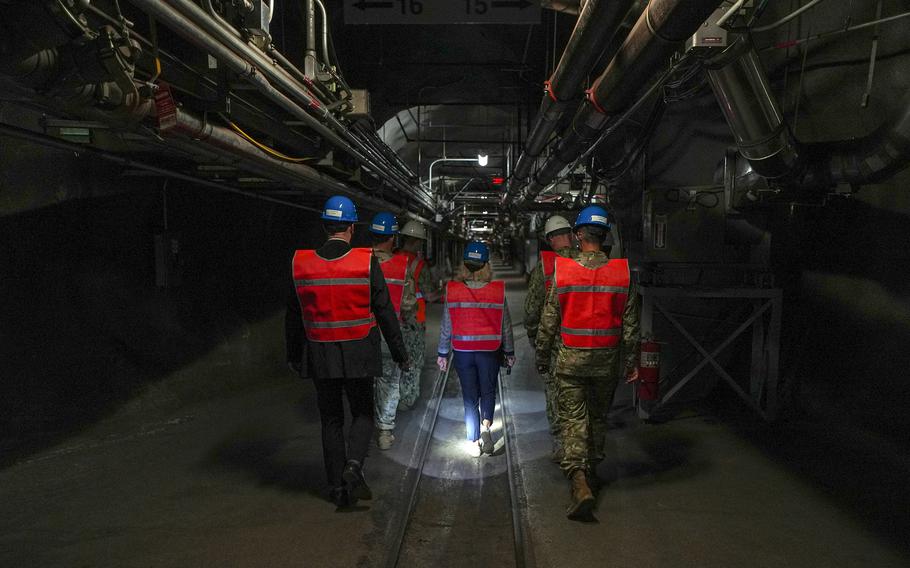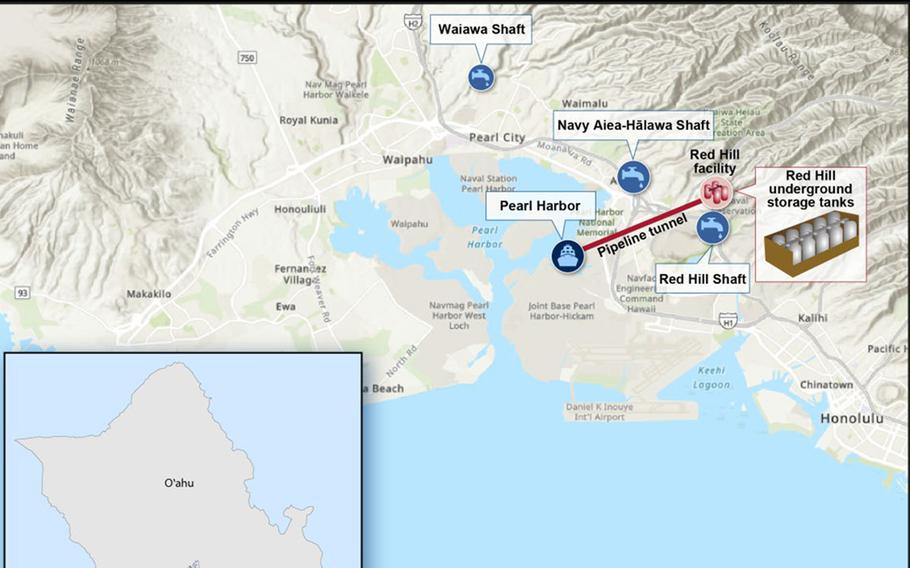
A pair of Defense Department task forces are emptying fuel and planning the closure of Red Hill Bulk Fuel Storage Facility near Joint Base Pearl Harbor-Hickam, Hawaii, after a 2021 jet-fuel spill leaked into the aquifer. (Matthew Mackintosh/U.S. Army)
The Defense Department has not adequately informed Congress of the anticipated costs of fully cleaning up the environment around the Red Hill underground fuel tanks in Hawaii after their closure, a government watchdog report said Wednesday.
A pair of Defense Department task forces are emptying fuel and planning the closure of Red Hill Bulk Fuel Storage Facility near Joint Base Pearl Harbor-Hickam after a 2021 jet-fuel spill leaked into the aquifer.
Defense Secretary Lloyd Austin in March 2022 ordered the World War II-era facility permanently closed.
Navy officials expect closure will be completed in 2027, with a plan to remediate decades of fuel contamination in the surrounding soil only being developed after that, the Government Accountability Office said in a 49-page report.
But the cost of remediating the site — after numerous spills and leaks over the past 80 years — remains a question mark, the GAO said.
“DOD had not, as of the end of fiscal year 2023, communicated information to Congress about total fiscal exposures for anticipated Red Hill remediation activities for fiscal years 2025 and beyond,” the report states.
“Specifically, DOD is aware of millions of dollars of costs that it is likely to incur as part of the Red Hill remediation and closure,” the GAO said. “It is also aware of numerous other costs for significant tasks that it cannot estimate at this time.”
In a report issued in November, a working group of Hawaii state and local officials estimated that as much as 2 million gallons of fuel may have leaked and spilled into the ground in the years since the facility was built.
Unknown future costs
The GAO report recommends that the Defense Department clearly identifies “anticipated costs for defueling, remediating, and closing Red Hill in supplemental reports or other budget materials, updating the information as more is learned.”
Among the costs projected for 2025 and beyond are $10 million annually to operate a water treatment plant for the area; $3 million for removing pipelines; hundreds of thousands of dollars each year for the Defense Health Agency to track health effects on those who were affected by tap water contamination; and hundreds of thousands more annually to extract petroleum vapors from the soil, the GAO said.
The costs of other needed cleanup methods remain unknown until dismantling the facility is further along, the GAO said.

A map shows the location of the Red Hill Bulk Fuel Storage Facility in relation to three water wells maintained by the Navy at Joint Base Pearl Harbor-Hickam, Hawaii. (Government Accountability Office)
The Defense Department estimated some costs in a 2022 report to Congress, but that projection did not cover expense estimates for fiscal years 2025 and beyond, the GAO said.
During that period, the Defense Department will “incur substantial costs related to remediating and closing Red Hill,” the GAO said.
“For fiscal year 2025 and beyond, DOD has indicated that the President’s budget request will include costs related to cleanup and closing of Red Hill as part of the normal budget process,” GAO said. “However, DOD officials stated that they did not discuss in detail with congressional oversight personnel the known and unknown future costs related to the closure of Red Hill.”
Closure in place
Congress has already appropriated large sums of money to deal with the Red Hill disaster.
It appropriated $1 billion in 2022 — funds that remain available through September 2024 — for improving infrastructure and defueling at Red Hill.
Congress later appropriated an additional $200 million for similar purposes.
As of Sept. 30, the Defense Department had obligated about $629 million of those funds and spent $67 million of it, the GAO said.
For the Defense Department, many unknowns make estimating Red Hill costs difficult.
For example, regulators with the U.S. Environmental Protection Agency and the Hawaii Department of Health have not yet approved the closure method for the 20 massive underground tanks.
The Navy’s preferred method is to clean the tanks and leave them in place, rather than remove or fill them, the GAO said.
The Navy is in discussions with the EPA and Hawaii Health Department over how that would be done, the GAO said.
Some local Hawaiians, however, insist that the tanks be permanently altered so they can never again be used to store fuel.
Filling or removing the tanks would add to the as-yet-unknown final costs of closing Red Hill.